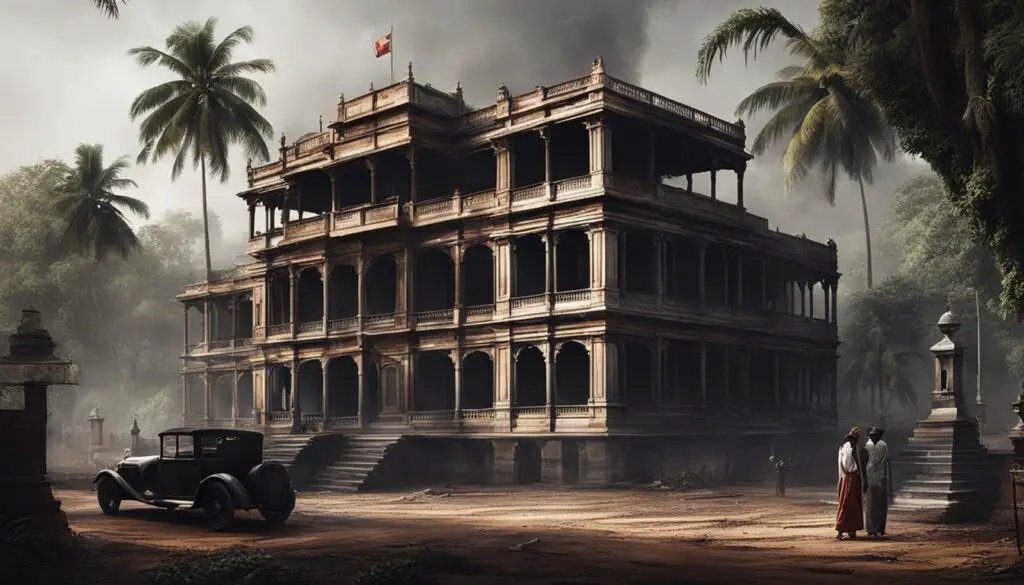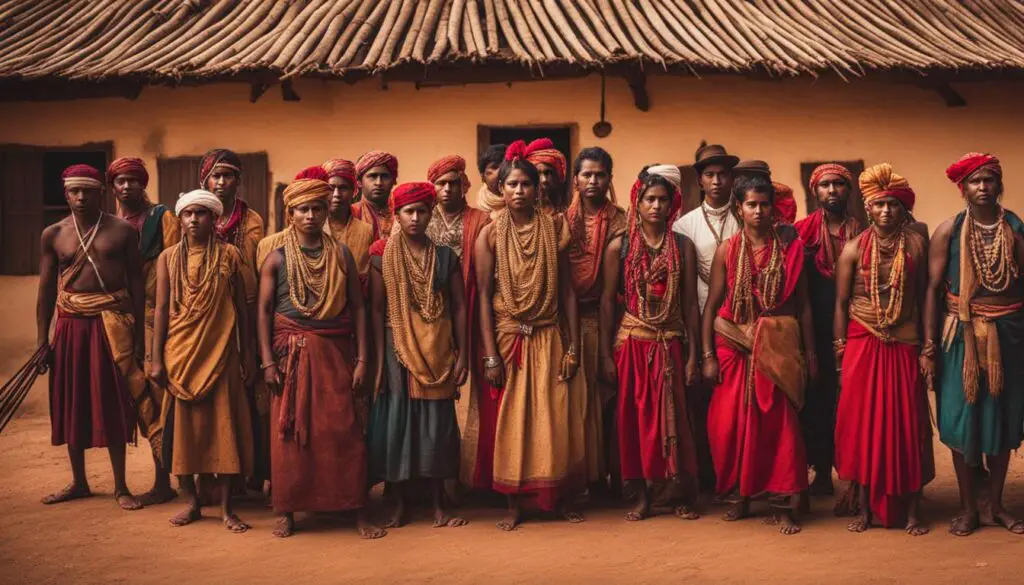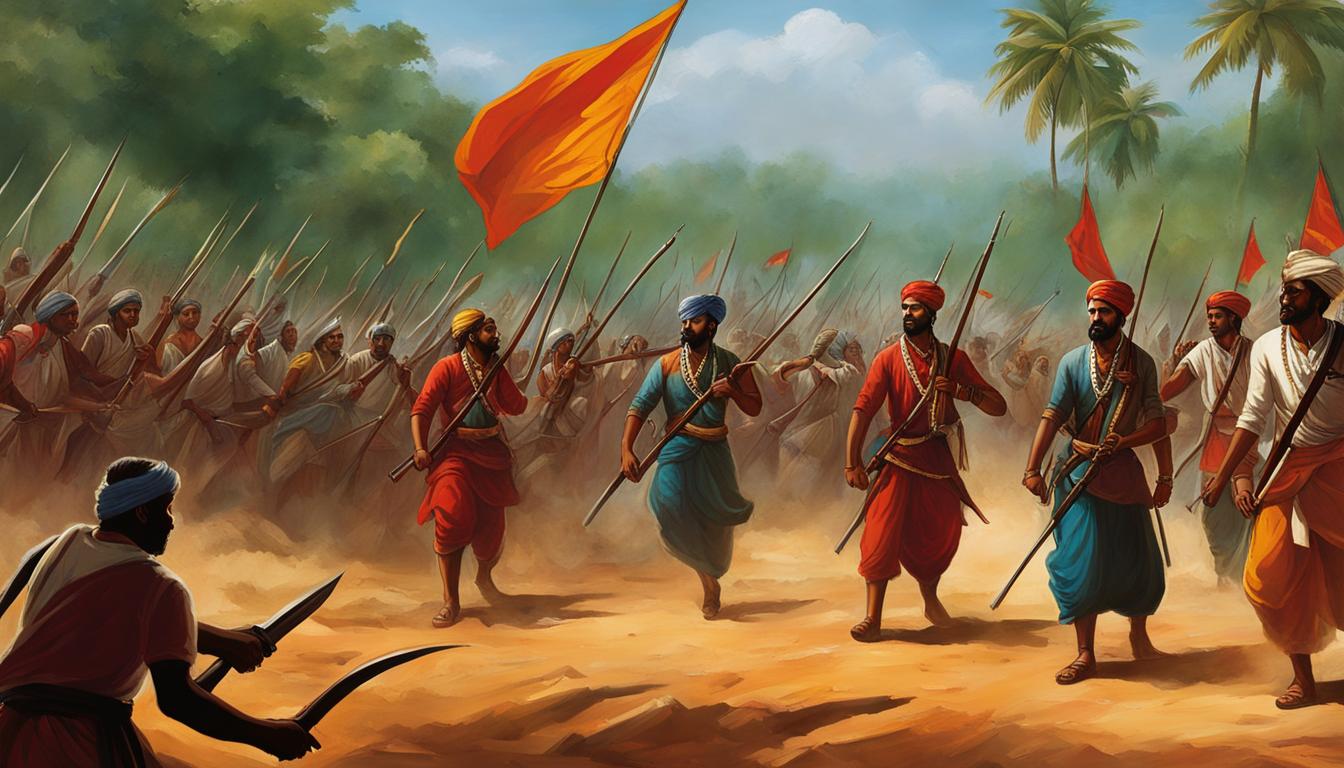Welcome to our article on the Attingal Revolt, a significant chapter in the resistance history of colonial India. In 1721, this uprising in the region ruled by the queen of Attingal became one of the earliest successful resistances against British colonialism. The Attingal Revolt serves as a testament to the brave spirit and unwavering determination of the native people against foreign rule.
Key Takeaways:
- The Attingal Revolt in 1721 was one of the earliest successful resistances against British colonialism in India.
- The uprising resulted in the murder of 130-odd Englishmen by native forces.
- The queen of Attingal, Aswathi Tirunal Umayamma Rani, played a prominent role in the region and was known for her valour, beauty, and diplomacy.
- The revolt was influenced by factors such as Dutch monopoly, British trade practices, and religious tensions.
- Kudaman Pillai, a prominent minister, organized the revolt and invited kalari experts to train the locals in combat.
The Background and Causes of the Revolt
The Attingal revolt in colonial India was shaped by several key factors, including the presence of British colonialism and the Dutch monopoly in the region. Let’s delve into the background and causes that fueled the uprising.
The British and Dutch Colonial Powers
In the early 18th century, the Dutch East India Company held a monopoly on trade along the Kerala coast, including the valuable spice trade. However, the British East India Company sought to establish their influence in the region and break the Dutch monopoly.
By offering better trade terms and appeasing local rulers, the British successfully made inroads into the region. One such ruler was the queen of Attingal, Aswathi Tirunal Umayamma Rani, who granted the British permission to build a fort at Anchuthengu. The queen hoped this would end the Dutch monopoly and bring prosperity to her kingdom.
This move, however, sparked discontent among farmers, traders, and feudal lords who felt exploited by the British trade practices. They protested against the preferential treatment given to the British, which further escalated the tensions in the region.
Trade Practices and Exploitation
The British East India Company gained exclusive rights to buy pepper at a cheaper rate than what the Dutch were offering. This unfair advantage caused great dissatisfaction among farmers and traders who relied on this spice trade for their livelihoods.
Feeling exploited and disregarded, these individuals became increasingly resentful towards the British, further fueling the growing tensions in the region.
Religious Tensions and Disrespect
Religious tensions also played a significant role in the Attingal revolt. The English, in their pursuit of properties and resources, disrespected the customs and beliefs of the native population.
One particular incident that intensified religious tensions was the English purchase of properties near the Sarkaradevi temple. This act was seen as a direct violation of the locals’ religious sentiments and traditions, leading to heightened anger and resentment against the British presence.
“Through their trade practices and disregard for our customs, the British made it clear that our land was merely a means for their profit. This fueled our determination to rise against their colonial rule.” – Local trader
The Image of British Colonialism in Attingal
To visually capture the essence of British colonialism and the ensuing revolt, take a moment to reflect on this image:

| Factors | Impact |
|---|---|
| Dutch Monopoly | Controlled trade, stifling local economic growth |
| British Trade Practices | Exploitation of farmers and traders |
| Religious Tensions | Disrespect of customs and beliefs |
The table above highlights the key factors that influenced the Attingal revolt, shedding light on the impact of Dutch monopoly, British trade practices, and religious tensions.
Stay tuned for the next section, where we delve into the details of the Attingal revolt and its aftermath.
The Revolt and its Aftermath
Kudaman Pillai, a prominent minister of the Attingal kingdom, played a pivotal role in organizing the revolt against the British. Recognizing the formidable power of the British and their advanced weaponry, Pillai devised a strategic plan to empower the native population. He invited kalari experts from both the north and south to train the locals in combat techniques, preparing them for the resistance.
The revolt eventually culminated in a devastating massacre of the entire British crew. Historians estimate that the casualties ranged from 23 to 133 Englishmen, highlighting the effectiveness of the native resistance and their determination to reclaim their freedom.
Debate surrounds the extent of the queen of Attingal’s involvement in the revolt. Some historians speculate that she silently approved of the attack, while others argue that she may have been unaware of the uprising. Regardless, the queen’s role remains a subject of historical inquiry, further deepening the intrigue surrounding the revolt.
In the aftermath of the revolt, the British demanded a substantial compensation from the queen and her administration. The British persecution extended to the queen’s ministers, including Kudaman Pillai, who faced severe consequences for their participation in the revolt.
Ultimately, the Attingal kingdom was annexed by the Travancore dynasty, led by Marthanda Varma. The merge with the Travancore state reshaped the political landscape, leaving a lasting impact on the region.

| Key Points: | Repercussions: |
|---|---|
| The revolt led by Kudaman Pillai | British demand for compensation |
| Magnitude of British casualties | Persecution of the queen’s ministers |
| Debate about the queen’s involvement | Annexation by the Travancore dynasty |
Conclusion
The Attingal revolt holds great significance in the history of native resistance against colonial powers in India. Despite being one of the earliest and most successful uprisings against British colonialism, it is often overlooked in historical accounts. The revolt of 1721 inspired unity among the people of Attingal, transcending caste, class, and religious barriers, and showcased their deep-rooted nationalistic fervor and love for their motherland.
Unfortunately, the British attempted to downplay the incident, and palace historians were concerned about its impact on foreign trade. Consequently, the brave resistance of common men – farmers, fishermen, and traders – against the colonial power became an overlooked history. The Attingal revolt serves as a testament to the agony and humiliation suffered by the natives at the hands of the British and deserves greater recognition in the narrative of India’s struggle for freedom.
The revolt not only demonstrated the native resistance against colonial oppression but also highlighted the significance of nationalistic fervor. Despite the lack of royal patronage, the people of Attingal rose up against the British, driven by their love for their homeland. This overlooked history serves as a reminder that the struggle for freedom and independence was not limited to notable figures but involved the collective strength and determination of ordinary individuals.
As we delve deeper into the Attingal revolt, it becomes clear that it was not just a local incident, but part of a larger movement against colonial powers. Native resistance remains a crucial aspect of India’s history, highlighting the courage and resilience of its people. It is essential to acknowledge and preserve this overlooked history to gain a comprehensive understanding of India’s journey towards independence and inspire future generations to cherish their heritage.
FAQ
What was the Attingal Revolt?
The Attingal Revolt was a resistance movement against British colonialism that took place in 1721 in the region ruled by the queen of Attingal in India.
Who played a prominent role in the Attingal region during the revolt?
The queen of Attingal, Aswathi Tirunal Umayamma Rani, played a prominent role in the region during the revolt, known for her valour, beauty, and diplomacy.
What were some of the causes of the Attingal revolt?
The revolt was influenced by factors such as the colonial powers of the British and the Dutch in the region, tensions related to trade practices, and disrespect of the natives’ customs and beliefs by the English.
How did the revolt unfold?
Kudaman Pillai, a prominent minister of the Attingal kingdom, organized the revolt and trained the local population in combat. The revolt culminated in the massacre of the entire British crew, resulting in casualties ranging from 23 to 133 Englishmen.
Was the queen of Attingal aware of the revolt?
Historians debate whether the queen of Attingal was aware of the attack, with some attributing the revolt to her silent approval.
What were the repercussions of the revolt?
Following the revolt, the British demanded compensation from the queen, and her ministers, including Kudaman Pillai, faced persecution. The Travancore dynasty eventually annexed Attingal and merged it with the Travancore state.
Why is the Attingal revolt significant in the history of native resistance against colonial powers in India?
The Attingal revolt is often overlooked in historical accounts but stands as one of the earliest and most successful uprisings against British colonialism. It inspired unity among the people of Attingal and serves as a testament to the resistance of common men against colonial power.
